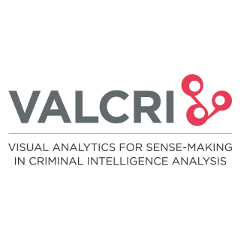Current Projects

The purpose of VALCRI is to create a Visual Analytics-based sense-making capability for criminal intelligence analysis by developing and integrating a number of technologies into a coherent working environment for the analyst we call the Analyst Reasoning Workspace. Conceptually, the workspace comprises three areas: (i) a Data Space for visualising data and themes, (ii) an Analysis Space into which data can be brought to carry out various computational analysis, and (iii) a Hypothesis Space that will enable analysts to assemble their evidence into coherent arguments.

The aim of INVISQUE is to improve sense making and knowledge discovery in large and complex datasets by making use of visual and spatial cues. The original design concept was conceived by Professor William Wong, at the Interaction Design Center, Middlesex University. The early design prototypes were implemented by Steel London. Since then, the INVISQUE prototype has been advanced and used in research into user interfaces to support investigative processes in defence, security, and as diverse as entertainment, and low literacy users.
Previous Projects

The UK Visual Analytics Consortium (UKVAC) is a partnership of UK universities with a shared interest in establishing a multi-disciplinary scientific community in the UK dedicated to promoting and contributing to the visual analytics research and development agenda in the UK. UKVAC is coordinated from Middlesex University and includes Imperial College London, Oxford University, Bangor University and University College London. UKVAC is working with the support of the US Department of Homeland Security via Pacific Northwest National Laboratory, Washington State, and in close collaboration with the UK Home Office.

CRISIS (Critical Incident Management System using an Interactive Simulated Environment) is a 36‐month, 12-partner, FP7 project aimed at developing a train-on‐demand simulation platform, which adapts advance video games technology to train first responders and crisis managers. CRISIS will support both collocated and distributed training across different emergency service organisations. The key problem with existing live training is that it is infrequent and expensive, and planning and coordination require major efforts (including trainees, instructors, observers and role-players).

Making Sense is an EPSRC funded project that grew out of EPSRC Sandpit on Detecting Terrorist Activity held in May 2009. The project’s aim was to develop tools and techniques for the analysis and visualization of multiple sources of multi-modal data that may be partial, unreliable and contradictory.

3D-in-2D Display Project is a 3 years project which kicked of in January 2007 founded by EUROCONTROL, the European Organization for the Safety of Air Transportation. The overall aim is to devise ways to present 3D information to air traffic controllers in the context of the traditional 2D radar display.
AD4 Virtual Airspace Management
In this project we are part of an European consortium to develop a new 4D (3D + time) interface for improving air traffic management in the approach and tower control operations area. We are investigating high level operations concepts and how that determines representation design requirements and hence what it means for designing 3D interfaces for air traffic management.
Novel Interfaces For Socially Disadvantaged
In this project we are working with a local Citizen’s Advice Bureau (a volunteer organisation that helps socially disadvantaged people with problems) to develop an interactive electronic community notice board (iceBoard) and environment for public services and information. The problems being addressed include how to develop interfaces that provide answers rather than lists of lists to people who have low or limited information seeking and literacy skills. One approach we have adopted is the development of novel interaction and visualisations that provide context while accessing detailed information to minimise getting lost in a large website, or when required public service information is distributed across several different government ‘silos’ or websites.
Novel Interaction And Visualisation Design For Multi-Layering Of Information
In this area we are researching the utility of visualisation and interaction capabilities of a new technology called the Multi-Layered Display. From this we will then investigate how such designs can be made, and then (i) develop the OS-level software architecture for using the MLD and (ii) help the company develop applications that can make use of it. Our target domain at the moment are those where information changes rapidly and where the information density is high, e.g. command and control, financial markets.
Interaction And Visualisation Strategies For Situation Awareness And Decision Making In Dynamic And Complex Environments
This area is based on our research using Cognitive Task Analysis to investigate the nature of demands placed on operators situation awareness and decision making in naturalistic decision making environments as diverse as command and control, laproscopic surgery, and identifying the cognitive strategies of of vehicular navigation among the older population. We are developing techniques to support information handling strategies in these domains, and also to inform the design of surgery training and assessment packages. Some of this work is based on previous studies of various emergency ambulance control centres in NZ, Australia, Scotland, Wales and England.
Digital Libraries For Cultural Heritage
One of our projects involve understanding how old photographs of historical value can be digitally archived and yet remain accurate and readily accessible. Issues are not so much just technical, but also social and curatorial.
Multimedia And Cultural Heritage
In this project area we ask the question of how do we replicate or augment the interaction with virtual reality museum artefacts? especially those artefacts where a high degree of visual interpretation of the artefact is required e.g. ancient vases where cracks are important as they contribute to the significance and value of the artefact.
Collaboration In Dynamic Work Domains
In this project area, our studies attempt to understand the nature of the common information spaces, particularly between air traffic controllers in ATC environments; and with the study of interaction and collaboration problems with distributed team collaboration tools such as airborne collision avoidance systems.
Socio-Cultural Influences In Individual-With-Technology Interactions
In this project area we explore how do individuals from different socio-cultural backgrounds interact with e-commerce and e-learning systems that are internationally accessible.
Affective computing – fun and engagement with technology
What counts as fun and engagement? what characteristics of technologies are implicated in producing these affective responses? how can we use such knowledge in design? these are some of the issues being investigated in this area of work.
Leave a Reply